According to a recent Freedom of Information (FoI) request, Transport for London (TfL) carried out 36,000 private hire and taxi vehicle inspections between February and September 2025.
The request broke down the top reasons vehicles failed their first test, and revealed exactly how many were unsuccessful.
Just like your annual MOT, inspections ensure that high vehicle standards are maintained across the board, ensuring a safe environment for both drivers and passengers. These tests are an important step in receiving and renewing your private hire licence.
With this in mind, let’s take a closer look at the top five reasons private hire vehicles failed their inspection, and how you can avoid the same outcome.
Issue 1: Damage to bodywork
Visible scratches, dents and bumps topped the list for most common reason for vehicle inspection failures. While some minor scratches may be acceptable, significant or major damage will likely not be passed.
Ridesharing platforms like Uber expect vehicles to meet strict standards, including body work and panel conditions. Any visible damage could make passengers feel uncertain about the safety or maintenance of the vehicle, which could result in lower ratings for you.
How to fix bumps and scrapes
Minor bumps, scratches, and scrapes are a reality of working on the road. Should any damage occur, it’s important to get it remedied as soon as possible before your inspection.
If you’re already insured with INSHUR, and have been involved in an incident that caused damage to your vehicle, you can file a claim with our support team for damages to help cover the cost (depending on your coverage level). Alternatively, research local body shops and garages that offer exterior works to keep your vehicle compliant.

Issue 2: Missing private hire vehicle insurance documents
Second on the failures list is not presenting your current hire and reward or private hire insurance certificate, or not having insurance.
Holding current private hire insurance is integral to your job, and it’s mandatory. It shows that you’re covered should you be involved in an incident, and demonstrates that you are a trusted driver who prioritises the protection of yourself, your passengers, and other road users.
In short, if you’re not covered, you won’t be granted a private hire licence, and you’ll be unable to work.
How to get private hire insurance, and where to find your insurance certificate
Need highly trusted private hire insurance quickly? Consider INSHUR!
We make buying insurance online easy - simply log in, answer a few questions, and accept your quote. We offer four levels of insurance to suit your needs, with two choices of policy length, and the option to spread the cost of an annual policy to help with budgeting. Plus, drivers with a high Uber star rating could get a better price at renewal. It pays to be safe.
You could be covered in minutes! Every driver who starts a quote with us has access to their Driver Dashboard. This is where your quotes are held, so you can pick up where you left off. You’ll also find all your insurance documents here ready for downloading - no searching through emails when you’re in a hurry (all documents will also be emailed to you when you purchase insurance).
Don’t let a missing document stop you from working. If you need trusted private hire insurance fast, get a quote with INSHUR today. We’ll email your certificate immediately so you’re always ready for inspection.
Issue 3: DVLA V5 or V5c document is missing or out of date
The V5 or V5c document, or logbook, is an official document issued by the DVLA that shows the registered keeper of a vehicle.
It includes crucial details about the vehicle’s history, including previous keepers, special notes (e.g. if the vehicle has been used as a taxi), and specific vehicle details like the registration number, engine size, fuel type, colour, make, and model.
Ridesharing platforms require this important document as it proves the vehicle is suitable for private hire use. Certain information on the V5c should exactly match the same information on your Private Hire Vehicle Licence and your ridesharing account, such as vehicle registration, make, and model.
How to get a V5 document
When you purchase a vehicle, the seller should provide you with the vehicle’s current V5 logbook. On the back, there will be a section to fill out your details as the new buyer. You can then post this to the DVLA, who will issue you with a new V5 logbook in your name.
It’s important when buying the vehicle to make sure that all sections of the logbook have been filled out correctly, with no corrections (like Tipp-Ex) or obscured details.
If you’ve lost your logbook, the DVLA will issue you a new one for £25. Tap to find out how to replace your V5C logbook.
Issue 4: Illuminated warning lights on the driver dashboard
Having one or more lights illuminated on your dashboard (not counting the handbrake) will result in an inspection fail.
Warning lights act as an alert that something is potentially wrong with your vehicle. Generally, a yellow or orange light indicates that a potential problem should be checked, while red lights mean you need to take immediate action. As a professional driver, warning lights should be inspected, diagnosed, and fixed as soon as possible.

Keeping on top of warning lights
While some warning lights are more crucial than others, it’s important to fix them as they arise. Regularly checking oil levels, tyre pressures and headlights will help keep some of the most common warnings at bay.
Getting your vehicle serviced regularly and making sure you book in for your annual MOT all aid in maintaining your vehicle to a high standard.
If any lights do show up, don't ignore them! They could point to a major issue.
Get to a garage or mechanic as soon as possible to avoid potentially serious damage to your vehicle.
Issue 5: Bad paintwork
Dull, faded, peeling, or otherwise damaged paintwork is the last of the top 5 reasons that vehicles failed inspections.
Ridesharing platforms hold their vehicles to high cosmetic standards, both internally and externally. Faded paintwork could indicate that a vehicle is not well-maintained, which could send a signal to passengers that their ride is unsuitable.
How to stay on top of vehicle maintenance
To build trust with your passengers and maintain a professional image with your passengers, make sure you take your vehicle for regular cleaning and valeting services.
Valeting, polishing, and waxing can help prevent common problems like peeling or flaking paint and combat sun damage. While it is possible to fix faded paint from home, you could save money in the long run by taking your vehicle to a professional detailer who can refresh your paint for you.
To finish
These were the top 5 reasons vehicles failed their TfL inspection tests from February to September this year. In that period, the pass rate for private hire vehicles was 88%, which means over 4,300 vehicles failed.
A failed inspection means a driver is unable to work, which can be detrimental to their income. Don’t let yourself be one of them! Fix dents and scratches, make sure all your documents are organised and accessible, and maintain routine maintenance and general upkeep.
Your job is driving; our job is protecting your livelihood. We make getting rideshare insurance simple. Stop worrying about paperwork and start driving - get your INSHUR quote today.
Sources:
The AA - Dashboard warning lights

.png)
.png)
